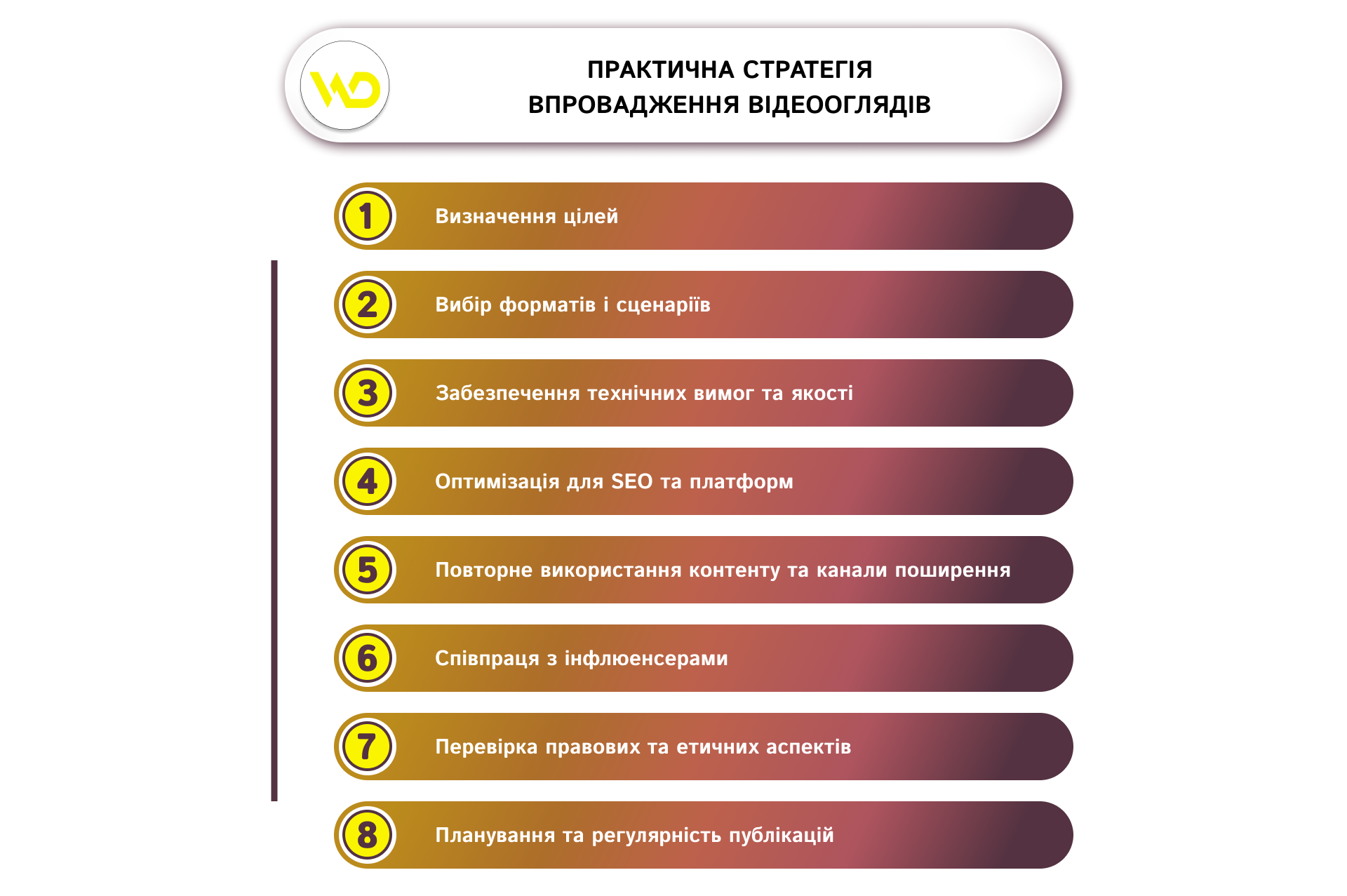Content of the article
- /01 What is a video review?
- /02 How video reviews influence customer decisions
- /03 Where and when video reviews are most effective
- /04 A practical strategy for implementing video reviews
- /05 How to measure the effectiveness of video reviews
- /06 Examples and case studies: how video reviews are changing business
- /07 Common mistakes when creating video reviews


In recent years, video reviews have become one of the most powerful marketing tools that influences customers’ choices as much as discounts or a well-known brand. In this article, we’ll look at how video reviews influence customer decisions and sales, what psychological mechanisms are involved, and in which business areas they work best. You’ll also find a step-by-step strategy for creating and implementing video reviews, a list of metrics for measuring effectiveness, and tips on how to avoid common mistakes. This material will help you understand how to turn video reviews into a systematic tool for growing trust and sales.
What is a video review?
A video review demonstrates a product or service in action, showing not only the features but also the practical experience of using it. Unlike textual descriptions or photos, it gives a complete picture: what the product looks like in reality, how convenient it is, and what emotions it evokes. Video reviews reduce uncertainty, build trust, and motivate purchases, making them a key tool in modern marketing.
How video reviews influence customer decisions
Video reviews work as a powerful psychological trust trigger. They demonstrate the product in real conditions, which reduces the doubts of a potential buyer and creates the effect of a «trial purchase» without financial risk. The main mechanisms of influence are as follows:

Social proof
Video reviews are often filmed by real users or independent bloggers. Their feedback is perceived as unbiased, which increases the level of trust more than the official description on the website. The video shows product features and practical experience: for example, how user-friendly the interface is, whether the product meets expectations, and how quickly the result is visible.
Emotional impact
The author’s tone, facial expressions, and gestures convey emotions that are easily read by the audience. If the reviewer is sincerely satisfied with the purchase, the viewer subconsciously transfers this positive experience to themselves, forming an emotional connection that is difficult to achieve with other marketing tools.
Speed up the purchase decision
Watching a video allows you to quickly assess the suitability of a product for your needs and reduce the time it takes to compare options. This is especially important for complex or expensive products where visibility and trust are crucial.
As a result, video reviews are transforming from a simple product demonstration to a key element of consumer behavior: they build trust, shorten the path to purchase, and increase customer satisfaction.
Where and when video reviews are most effective
Video reviews are not a one-size-fits-all solution for all products and all stages of the marketing funnel. Their effectiveness depends on the type of product, the specifics of the audience, and the moment of interaction with the customer. A proper understanding of these nuances allows you to maximize the use of the video resource and avoid wasted costs.
Niches and product categories
Video reviews work especially well in those segments where it is important to demonstrate real functionality or aesthetic effect:
- technology and electronics (smartphones, gadgets, household appliances). The video shows how the device works, the interface, and the speed of its functions. The client sees real results and realizes whether the product will suit him or her in everyday life;
- cosmetics and care products (makeup, skin care, hair care). Here, it is important to demonstrate the «before» and «after» effect, texture, and methods of application;
- fashion and accessories (clothes, shoes, bags). The video allows you to evaluate the fit, mobility, and combination with other wardrobe elements;
- home and interior products (furniture, decor, lighting). Video helps to assess the scale, quality of materials, and practicality in everyday life.
- Sports goods and equipment (exercise equipment, gear, accessories). The client sees the process of use, the level of complexity, and efficiency.
In all of these niches, video is becoming not just an advertising format, but a way to give the customer a user experience before they buy, and this is often the decisive argument. Next, it is important to understand at what stages of the sales funnel this format works most effectively.
Stages of the sales funnel
The effectiveness of video reviews also depends on the stage of the customer’s journey:
- Consideration – a potential customer compares products and looks for reliable sources of information. Here, a video review helps to distinguish your product from competitors and reduce uncertainty.
- Decision – the customer is already interested, but has doubts about a particular model or brand. A high-quality video demonstrates the practical benefits and confirms the right choice.
- after the purchase (Retention / Advocacy) – video reviews with real users or bloggers can motivate repeat purchases and recommendations to friends.

Based on these factors, businesses can choose the best products and stages of the video review funnel to maximize the effectiveness of their marketing efforts.
A practical strategy for implementing video reviews
For video reviews to really bring results, their creation and implementation requires a systematic approach. It’s not just about recording a product on camera – it’s a complex process that includes planning, scripting, technical implementation, distribution, and analytics.

Setting goals
Before starting production, it is important to clearly define what you want to achieve. It can be to increase brand trust and awareness, increase conversions on a website or marketplace, demonstrate key product features, or encourage repeat purchases. A clear understanding of the goals allows you to create content for specific business objectives and makes video as effective as possible.
Choosing formats and scenarios
The type of video determines how the audience will perceive it and how useful it will be. You can choose from demo reviews that show the product in action and explain its functions, comparative reviews to show the advantages of your product over competitors, real customer reviews, or reviews with influencers to help attract a new audience. The script should include an introduction, demonstration of key features, emotional comments, and a clear call to action.
Ensure technical requirements and quality
Video quality directly affects audience trust. It’s important to ensure a clear image, a stable camera, sufficient lighting, and a clean background to keep the focus on the product. High-quality sound without noise makes viewing comfortable. The optimal length of the main review is 2-5 minutes, while short versions for social media are up to 60 seconds, which helps to keep users’ attention.
Optimization for SEO and platforms
Video should work not only for emotional perception but also for search visibility. To do this, it is important to add keywords to titles, descriptions, and tags, use transcripts, and links to the product and related materials. This helps potential customers find information easily and increases the effectiveness of marketing channels.
Content reuse and distribution channels
Video reviews can be adapted to different formats and platforms, which allows you to increase your reach and save resources. It is advisable to post them on the company’s website, social media, and use them in email newsletters, advertising campaigns, and marketplaces. This approach allows you to maximize the effect of one material.
Cooperation with influencers
Influencers and bloggers with a relevant audience can further increase the credibility of the product. It’s important to make the review look sincere, not promotional, as authenticity is a key factor in the effectiveness of a video review.
Checking legal and ethical aspects
Compliance with copyright, advertising laws, and the accuracy of the information presented are mandatory. If the video is sponsored or contains gifts, this should be noted. This approach helps to avoid negative consequences and builds the reputation of a responsible brand.
Planning and regularity of publications
The systematic implementation of video reviews provides a long-term effect: regular new videos maintain the interest of the audience, accumulate content for reuse, and form a stable marketing channel.
In general, a well-thought-out strategy for implementing video reviews allows you not only to demonstrate the product, but also to create a comprehensive experience for the customer, build trust and increase the effectiveness of marketing efforts.
And the next logical step is to evaluate how to measure the effectiveness of video reviews to know exactly which materials bring the greatest impact and how to optimize them for future campaigns.
How to measure the effectiveness of video reviews
For video reviews to bring real results, it’s not enough to just create and post them. It’s important to regularly evaluate the effectiveness, track the impact on sales, and make data-driven decisions. For this purpose, key performance indicators (KPIs), analytical tools, and A/B testing are used to optimize content and marketing strategy.
Key KPIs for video reviews
- CTR (Click-Through Rate) is a click-through rate. It shows how many people have watched the video and gone to the product page. This is one of the key indicators of how much a video motivates viewers to take the next step.
It is calculated using the formula:

Example: a video has 5000 views and 350 clicks to the product page. So, CTR = (350 / 5000) × 100 = 7%.
A high CTR indicates the relevance of the content and an effective call to action.
- Retention Rate is the retention of viewers. It shows how much of the audience watches the video to the end. It helps to understand how interesting and understandable the content is.
The formula is as follows:

Example: out of 2000 views, 1200 viewers watched the video to the end. Retention Rate = (1200 / 2000) × 100 = 60%.
If the rate is low, you should revise the script, shorten long intros, or add more dynamic elements.
- Conversion Rate. Shows how many video views turned into a specific action: a purchase, subscription, addition to the cart, or request for a consultation.
The formula:

Example: 1000 users watched the video, 80 of them made a purchase. This means that Conversion Rate = (80 / 1000) × 100 = 8%.
A high conversion rate indicates the relevance of the content to the audience and the right choice of CTA.
- ROI (Return on Investment) – return on investment. ROI helps to assess how effective investments in video production are.
Here is the formula for calculation:

Example: video reviews brought in 50,000 UAH, and 10,000 UAH were spent on production. Therefore, ROI = (50 000 – 10 000) / 10 000 × 100 = 400%.
A high ROI shows that the costs have paid off many times over, and the investment in content is justified.
Use analytics and A/B testing
For video reviews to really work, it’s important to monitor how viewers interact with them. Analytics helps you understand which moments of the video attract attention and where users lose interest. For example, if the majority of views are cut off at the 30th second, this is a signal to revise the script or speed up the demonstration of key features.
A/B testing allows you to compare different approaches: you can change the splash screen, video duration, presentation style, or call to action. For example, one version of a review can show a product in a dry description, while the other version shows it in action with real use. Often, it is the second version that generates more conversions to the site, because the viewer sees the practical benefits of the product.
In addition, you should pay attention to different platforms. Audience behavior on social media may be different from YouTube or marketplaces, so the same video strategy may yield different results. The use of combined metrics – CTR, Retention and Conversion Rate – helps to get a complete picture of effectiveness.
Regularly updating video reviews allows you to take into account changes in the product, the reaction of competitors, and the needs of the audience. This systematic approach not only helps you understand which materials work best, but also increases the effectiveness of future videos, optimizes costs, and forms a solid basis for strategic decisions. Next, let’s take a look at how brands use video reviews to achieve their business goalsю
Examples and case studies: how video reviews are changing business
Here are some real-world examples of how companies use video reviews to achieve their goals: building trust, increasing awareness, and driving sales.
- FragranceX – 63% increase in conversion thanks to video reviews.
The online perfume store FragranceX conducted A/B testing comparing product pages with and without video reviews. The results showed that the conversion rate on pages with videos increased by 63%. This confirms the effectiveness of video reviews in increasing sales.
- Testimonial Donut – increasing engagement through video cases.
Australian startup Testimonial Donut uses video case studies to demonstrate the success of its customers. They found that LinkedIn videos have an average viewing time of 2 minutes and a high level of engagement. This proves the effectiveness of video cases in professional networks.
- Coach – 145 million views on TikTok.
The Coach brand created a video with TikTok’s platform star Sabrina Bahsoon that has received 145 million views. This shows how video reviews adapted to the specifics of the platform can significantly increase brand awareness among young audiences.
- Canva – 16-minute sales video.
Canva created a short video that demonstrates the ease of use of their tool. This video effectively communicates the value of the product and attracts new users, emphasizing the importance of clear and concise video reviews.
- Dropbox – video as a tool to attract investment.
Dropbox used video to showcase their product to potential investors. This helped them raise funding and expand their customer base by showing how video can be an effective tool in business strategy.
These examples demonstrate the diverse ways video reviews can be used to achieve business goals. They confirm that video reviews can be effective at different stages of the sales funnel and in different niches.
Common mistakes when creating video reviews
As we’ve already found out, video reviews can significantly increase brand trust and sales. But if you use the wrong approach, the effect can be zero or even negative. Let’s take a look at the most common mistakes and why you should avoid them.

Excessive video length
Videos that are too long quickly lose viewers’ attention. If the video lasts more than 3-4 minutes without a structured division into blocks, most of the audience will probably leave the video in the middle. It’s better to focus on the key points: product demonstration, its benefits, and real-world examples of use.
Lack of a clear structure
A video without a logical scenario or sequence of steps looks chaotic. The viewer may not understand what is being shown and what problem the product solves. It’s important to divide your video into blocks: introduction, demonstration of key features, comparison or case study, conclusion, and call to action. This helps to keep attention and make viewing comfortable.
Poor picture and sound quality
A blurry picture, shaky footage, or poor sound reduces brand credibility. The viewer subconsciously associates poor video quality with poor product quality. Investing in basic lighting, camera stabilization, and a microphone will pay off in trust and positive brand perception.
Lack of a call to action (CTA)
Even the highest quality video will not bring results without clear instructions for the viewer: buy, subscribe, download, or leave a review. It’s important that the CTA is natural, logically integrated into the content, and doesn’t look intrusive.
Use of template content
Copying other people’s reviews, repeating standard phrases, or overly artificial product demonstrations create a sense of insincerity. The audience appreciates real feedback and live emotions, so you should show the product in real conditions and let real users speak.
Ignoring analytics and feedback
Many brands make a video and simply publish it without analyzing its effectiveness. Without tracking views, audience retention time, and conversions, it’s impossible to understand what works and what doesn’t. Regular analysis allows you to optimize scripts, change the duration or format, and increase the effectiveness of your content.
Thus, effective video reviews combine quality, emotionality, and value for the viewer. Focus on the needs of your audience, test different formats, monitor KPIs, and take into account user feedback. This approach not only increases trust and sales, but also creates a strategic advantage for the brand, making it more recognizable and attractive to customers.






 30/10/2025
30/10/2025  1145
1145



